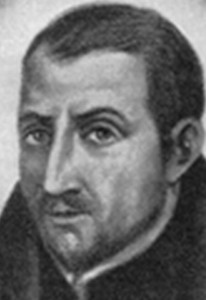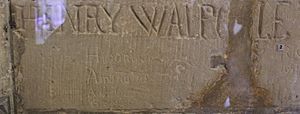Henry Walpole facts for kids
Quick facts for kids Saint Henry Walpole |
|
|---|---|
 |
|
| Born | 1558 Docking, Norfolk |
| Died | 7 April 1595 York |
| Venerated in | Roman Catholic Church |
| Beatified | 15 December 1929 by Pope Pius XI |
| Canonized | 25 October 1970 by Pope Paul VI |
| Feast | 7 April |
Henry Walpole was an English man who lived a long time ago, from 1558 to 1595. He became a Jesuit priest, which is a special kind of Catholic priest. He was executed in York because he refused to take the Oath of Supremacy. This oath would have meant he agreed that the Queen was the head of the church, but he believed the Pope was. He is remembered as a martyr, someone who died for their beliefs.
Early Life and Big Changes
Henry Walpole was born in 1558 in a place called Docking, Norfolk. He was the oldest son of Christopher Walpole. Henry went to school at Norwich School, then studied at Peterhouse, Cambridge university, and later at Gray's Inn to become a lawyer.
While he was studying law, government spies noticed him. He often spent time with people who were known as recusants. These were people who refused to attend Anglican church services and remained Catholic, which was against the law at the time.
A very important event changed Henry's life. He was there when another Catholic priest, Edmund Campion, was executed in 1581. Some of Campion's blood even touched Henry's clothes. This moment deeply affected Henry. Before this, he wasn't very serious about religious matters. But after seeing Campion's death, he decided to give up his law career. He wanted to follow Campion's path.
Henry secretly wrote a small book of poems to honor Campion. This book was printed and shared around London. The authorities tried to find out who was involved. The printer, a friend of Henry's, was punished but didn't tell on Henry. Still, Henry was suspected. He quickly left London and went to his family's home in Norfolk. From there, he managed to escape to France.
Becoming a Jesuit Priest
After leaving England, Henry traveled through cities like Rouen and Paris. He arrived in Reims on July 7, 1582. He then joined the English College in Rome in April 1583. In February 1584, he became a "probationer" for the Jesuits. This meant he was training to become a Jesuit.
He continued his studies in France. He became a priest in Paris on December 17, 1588. After that, he was sent to Brussels. Henry was very smart and could speak many languages, including Italian, French, Latin, English, and Spanish.
Henry stayed in Brussels for a year. Then, he was given a job as a chaplain for English and Irish Catholic refugees. These refugees were serving in the Spanish army in the Netherlands. During this time, he was captured and taken to an English fort. He was treated very badly there. Luckily, his brother Michael and his Jesuit leaders paid money to get him released.
After his release, he continued his training. He then helped to start new English seminaries, which are schools for priests, in Spain. These were in Seville and Valladolid. In 1593, he even traveled to see King Philip II of Spain. He asked for permission to start a new school, which later became Stonyhurst College in England.
Facing Danger in England
In 1593, Henry Walpole, his youngest brother Thomas, and an English soldier tried to sail back to England. They left from Dunkirk on a French ship. They were heading for Scotland because many ports in southern England were closed due to the plague. After ten days of rough seas, they landed at Flamborough Head in Yorkshire on December 4, 1593. They immediately split up.
However, Henry was betrayed by another passenger on the ship. This person was trying to earn money to get out of prison. Henry was arrested at an inn in Bridlington. He was then imprisoned for the next sixteen months.
Henry spent about three months in York Castle. Then, a man named Richard Topcliffe, who hunted down priests, had him moved to the Tower of London in February 1594. In the Tower, Henry was severely punished. He was stretched on a device called the rack and hung by his wrists for many hours. This happened fourteen times, spread out so he wouldn't die by accident during the questioning.
Henry's father was very ill. If Henry was found guilty of treason, his family's land would be taken by the Queen.
In the spring of 1595, Henry was sent back to York for his trial. Another priest, Alexander Rawlins, was also waiting for trial there. Both were tried on April 3. They were accused of being Catholic priests in England, which was against the law.
Henry, who used to be a lawyer, argued that the law only applied to priests who didn't turn themselves in within three days of arriving. He had been arrested less than a day after landing, so he argued he hadn't broken that specific law. The judges then demanded that he take the Oath of Supremacy. This oath would mean he accepted the Queen as the supreme head of the church. Henry refused to take the oath. Because of this, he was found guilty of a very serious crime against the queen.
Both Henry and Rawlins were found guilty and sentenced to death. On April 7, 1595, they were executed. Rawlins died first. Henry was allowed to die before his body was cut into pieces.
His Legacy
Henry Walpole was recognized as a blessed person in 1929. Then, in 1970, he was made a saint. He is one of the Forty Martyrs of England and Wales, a group of people who died for their Catholic faith in England. His special day is celebrated on April 7.
A book about Henry Walpole's life and death was written in Spanish by Joseph Creswell in 1596. Another biography was written by Augustus Jessopp called One generation of a Norfolk house. Jessopp also put together Henry's letters, which were printed in 1873.
Today, a Catholic church in Burnham Market, Norfolk, is named St. Henry Walpole Catholic Church in his honor.


